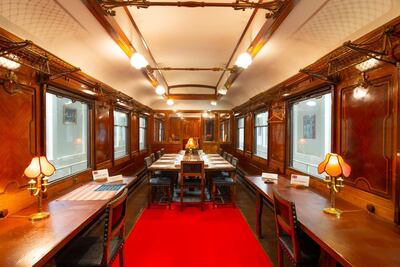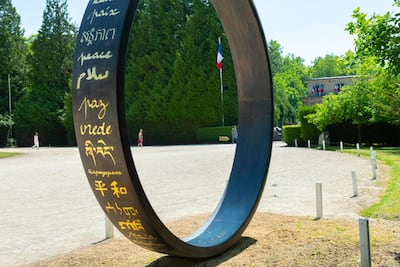The small memorial garden in a clearing in the Forest of Compiegne is dedicated to Augustin Trebuchon. It's not a familiar name. He was no great general or war leader, like Marshal Foch, whose statue stands proudly over the bigger, more primped section of the clearing.
One hundred years ago, history reached a momentous turning point in this glade. On November 11th, 1918, the Armistice drawing hostilities to a close during the First World War was signed here, in utmost secrecy after two days of negotiations.
The Glade of the Armistice memorial is shrouded by the stately autumnal forest of Compiegne, 78km north-east of Paris. It's an elegant and refined city, where the grand chateau built under the orders of king Louis XV, would otherwise be the main attraction. Inside, Napoleon's shocking magenta bedroom, the gold-columned ballroom and the stately map room are all on show to the public, and the attached park disappears off into the horizon. Compiegne has long been a major horse-breeding centre, and its horse-chestnut-tree-lined grand boulevards seem purpose-designed for riding down. But in 1918, the mode of transport that bore the most significance to the city was the train rather than horse.
The memorial museum at the side of the glade houses a dreamily handsome teak railway carriage emblazoned with the name of the Compagnie Internationale des Wagons-Lits. Originally, it was a dining car servicing the lines from Paris to Brittany, but during the First World War, it was commandeered and then eventually used as Foch's mobile office. Carriage 2419D is laid out as it would have been in 1918, with a central table that four men, each from the opposing delegations, were seated around. Foch, the commander-in-chief on the Western Front, was second from the right – a position someone else would insist on occupying 22 years later.
The rest of the museum tells us how the world got to this point. Europe’s high stakes system of defensive alliances – which included much of the Ottoman Empire in the Middle East; the assassination of Archduke Franz Ferdinand that sent all the dominoes toppling; the grim trench warfare stalemate; and German’s slow retreat in 1918. Guns and grenades are on show in cabinets, maps show the movements of the front line.
By November 1918, it was time to end the war that had seen millions die in the dirt from the Somme to the Sinai. Germany was the last hold out – the Ottomans had signed their own Armistice at Mudros on October 30, which would lead to much of the Middle East being arbitrarily divided up among the Allied Powers.
Compiegne, away from the front line and where locals were likely to be less hostile to the Germans, having not seen too many of the war's horrors, was chosen as the place to hammer out the ceasefire. The meeting was conducted in secrecy, with Foch keeping politicians and press away. He banned the taking of photographs – although one railway employee took grainy shots surreptitiously – and the German delegation was sneaked in from the front line.
But the story of the carriage doesn't end there. It would see another Armistice, this time during the Second World War. In 1940, the forces of Nazi Germany had overwhelmed France, and a surrender was on the cards. Adolf Hitler, filled with a burning sense of injustice at the way Germany had been treated after the First World War, saw an opportunity for revenge. He had the same carriage brought back to the same glade in the Compiegne forest, and insisted on sitting where Foch had sat while the French agreed to terms.
Then he had the whole site, memorials and all, razed, apart from the statue of Foch that still stands today. No one knows why it was allowed to remain standing, but presumably, it’s so that Foch could forever look over the destruction.

The carriage was later taken to Germany to be displayed in Berlin, then burnt down. The one now on display now is not the original – although it was made around the same time, and laid out exactly as the original Armistice Carriage would have been. This year, on the 11th hour of the 11th day of the 11th month, much of Europe will fall silent to commemorate the 100th anniversary of the First World War Armistice. It may come as a surprise to learn that it was signed at 5.15am, rather than 11am. But this was to give enough time for word to be spread along the front line, so that everyone could put their guns down together.
The most heartbreaking part of the museum covers arguably the most senseless death in a war full of millions of senseless deaths. At 10.50am, just 10 minutes before the ceasefire came into effect, a member of the 415th Infantry Regiment was killed while delivering a message to his captain. He was half-way between Sedan and Mezieres and was the last French soldier to die during the Great War. His name? Augustin Trebuchon.
______________________
Read more:
How the First World War shaped the borders of the Middle East
The forgotten Muslim heroes of WWI
Forgotten Muslim heroes of Great War immortalised in London exhibition



